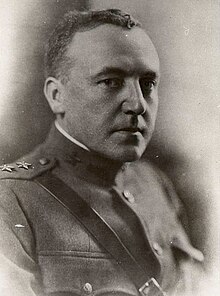Fox Conner
Fox Conner | |
|---|---|
 Major General Fox Conner | |
| Born | November 2, 1874 Slate Springs, Mississippi |
| Died | October 13, 1951 (aged 76) |
| Allegiance | |
| Service | |
| Years of service | 1898-1938 |
| Rank | |
| Commands | Hawaiian Department Panama Canal Zone First Corps Area First United States Army |
| Battles / wars | World War I |
| Awards | Distinguished Service Medal Croix de guerre |
Fox Conner (November 2, 1874-October 13, 1951) was a major general of the United States Army. He served as operations officer for the American Expeditionary Force during World War I, but is best remembered as "the man who made Eisenhower".
Early career
Conner was born at Slate Springs, in Calhoun County, Mississippi. He was appointed to the United States Military Academy in 1894, and served with the Cuban occupation force after graduation. He developed a reputation as a rising star in the Army, serving in the Army General Staff, as an instructor in the War College, and in several other positions in which he influenced the future direction of the Army.
World War One
During World War I, Conner was tapped by General John J. Pershing to be the chief of operations (G3) for the American Expeditionary Force in France with Colonel John McAuley Palmer under his immediate supervision. Another one of his subordinates was then-Lieutenant Colonel George C. Marshall, for whom Conner developed an immense respect, later recommending Marshall as the ideal soldier and a military genius. For his service as the "brain" of the AEF, Conner was awarded the Distinguished Service Medal and the Croix de Guerre. After the war, Conner wrote the after-action report that influenced the 1920 National Defense Act that set the course of the interwar Army.
Conner and Eisenhower
Conner's most lasting contribution was his mentorship of a young Army officer named Dwight Eisenhower. Conner first met Eisenhower in 1919 at the Infantry Tank School at Camp Meade and the two men immediately developed a great mutual respect. When Conner took command of the 20th Infantry Brigade in Panama, he invited Eisenhower to join his staff. For three years, Conner instituted a systematic course of study for Eisenhower that ranged from extensive readings in military history to daily practical experience writing field orders for every aspect of the command.
Conner had three principles or rules of war for a democracy that he imparted to both Eisenhower and Marshall. They were:
- Never fight unless you have to;
- Never fight alone; and
- Never fight for long.[1]
Of particular importance to Eisenhower's later career, Conner emphasized the importance of coalition command in preparation for the inevitable war. Said Eisenhower,
One of the subjects on which [Conner] talked to me most was allied command, its difficulties and its problems. Another was George C. Marshall. Again and again General Conner said to me, 'We cannot escape another great war. When we go into that war it will be in company with allies...We must insist on individual and single responsibility—leaders will have to learn how to overcome nationalistic considerations in the conduct of campaigns. One man who can do it is Marshall—he is close to being a genius.' [2]
Conner pulled strings to get his protégé admitted to the Command and Staff School at Fort Leavenworth, where Eisenhower graduated first in his class thanks in no small part to his comprehensive Panamanian tutelage.
Later service
Conner was promoted to major general in 1925 and assigned to Washington, D.C. as deputy chief of staff. He was Pershing's candidate for Chief of Staff in 1930, but was passed over in favor of Douglas MacArthur. He retired as commander of First Corps Area and First United States Army on November 4, 1938 after forty-four years of service.
Conner's greatest disappointment was that he never had the opportunity to lead troops in wartime. Like Marshall, Conner was considered too valuable a staff officer to be released into the field. Nevertheless, he served as role model and inspiration to future World War II high commanders like Marshall, Eisenhower, and George S. Patton. Eisenhower considered Conner to be the greatest soldier he ever knew, saying: "In sheer ability and character, he was the outstanding soldier of my time."[3]
See also
References
- ^ Gates, Robert (Summer 2008 issue). "Reflections on Leadership" (PDF). Parameters (Winter 2010-11). United States Army War College: 185–191. Retrieved August 25, 2012.
{{cite journal}}: Check date values in:|publication-date=(help) - ^ Dwight D. Eisenhower (1997). Crusade in Europe. JHU Press. ISBN 978-0-8018-5668-6.
- ^ Carlo D'Este (2003). Eisenhower: A Soldier's Life. Macmillan. ISBN 978-0-8050-5687-7.
Other sources
- Nineteen Stars; by Edgar F. Puryear, Jr. ISBN 0-89141-148-8 (paperback)
- The Next Middle East War; by Robert Gates, U.S. Secretary of Defense [1]
- Grey Eminence: Fox Conner and the Art of Mentorship; by Edward Cox ISBN 1-58107-203-1 (paperback)
Additional reading
- Cox, E. 2010. Grey Eminence: Fox Conner and the Art of Mentorship. New Forums Press. ISBN 978-1-58107-203-7
- Perry, M. 2007. Partners in Command: George Marshall and Dwight Eisenhower in War and Peace. The Penguin Press. ISBN 978-1-59420-105-9
